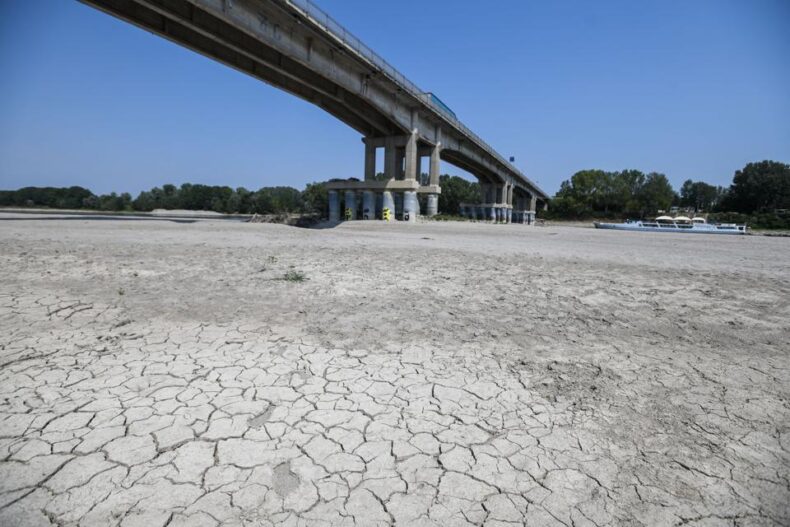New research on drought in Europe has come to light by the European Drought Observatory.
It states that 60% of Europe and the UK are experiencing drought conditions. The research further says that Europe is experiencing record-breaking summers due to climate change-driven heat.
The heatwave across Europe has led to a scarcity of freshwater, low crop yield, parched fields, and rivers drying up. With scorching heat and no signs of rainfall, crop fields are losing moisture.
In addition, farming on several lands has been restricted due to a lack of freshwater availability.
Continue reading:
- Depleting rivers indicate drought in Europe.
- Drought may escalate in the coming years.
- The situation is expected to carry on until October.

The heatwaves are in full effect in France too. Virginijus Sinkevičius, Commissioner for the Environment, said 100 municipalities in France do not have running water. The French government is setting up a committee to deal with the drought crisis.
The Rhine water levels in France and Germany are dropping every day, resulting in lesser good transportation via cargo.
Furthermore, Sinkevičius added the Netherlands is facing “an official water shortage”.
Major rivers depleting indicate Drought in Europe.
The Rhine river is one of Europe’s major rivers and immensely important in commerce. With the adversities of climate change and dramatic drop in river levels, cargo vessels cannot set sail.
A river that was once a major source of water for nearby industries, today has its sandbanks exposed to the sun.
Dropping water levels of Rhine will setback EU shipping, reducing transportation of goods resulting in a price hike for those goods.
Constantly depleting rivers, seas, and reservoirs are a cause of concern for European countries. Rhine, Po, Danube, and others show dangerously low levels of water resulting from the scorching heatwave.

The same conditions persist in Italy as well. River Po, Italy’s longest river, accounts for more than one-third of agricultural production in Italy.
As conditions continue to worsen, Italy declared a state of emergency for the areas around River Po.
If extreme heat persists, it will further worsen drought in Europe by making soil dry and lands parched.
In July, the temperatures rocketed above 104 degrees Fahrenheit across Western and Southern Europe. Dramatically diminishing water levels have left many hydro plants shut down.
This has affected energy production and is a hindrance to yielding crops.
In Italy, the situation worsens as one-fifth of Italy’s electricity is generated by hydro plants. With drought and heatwaves, Italy is also tackling a lack of power supply and cutouts.
Drought crisis may escalate in the coming years.
As a result of gruelling heat and low rainfall, riverbeds are drying up all across Europe. In the United Kingdom, the drought conditions are likely to remain until October, according to the Center for Ecology and Hydrology.
The United Kingdom’s capital London can see temperatures above 90 degrees (F) for consecutively four days, starting Thursday.

The continent will experience intense heat waves throughout this week. In addition, the temperature may soar as high as 100 degrees Fahrenheit in Spain, Portugal and parts of France throughout the week.
France is the largest producer of wheat in Europe. Unfavourable climatic conditions, scarcity of freshwater, and dehydrating agricultural lands are a grave concern for France.
Growing crops like corn have become troublesome too. The breadbaskets of Europe are suffering amid the Ukraine crisis. Food shortage in the given situation is a problem not far away.
Lands are drying up in other major manufacturers like Romania and Germany. This year’s harvest from France is estimated to decline 19% to 12.66 million tons, the agriculture ministry revealed in a report.
According to Crop Analyst Vincent Braak, “Even if rains come back, it is too late for yielding good corn production because pollination is done everywhere.
We are worried about all summer crops. Even with irrigation, this temperature is totally crazy.” This week marks France’s fourth heatwave.
According to scientists, this drought can be the worst to last in 500 years.
In addition to prevailing critical conditions, European countries can expect dry conditions and heatwaves throughout August and September.
The increase in carbon emissions is increasing the earth’s temperature. The ramifications result in sweltering heatwaves, droughts and other climatic shifts.
Environmentalists say such conditions are expected to persist for longer durations over time and can increase in intensity over the years.













